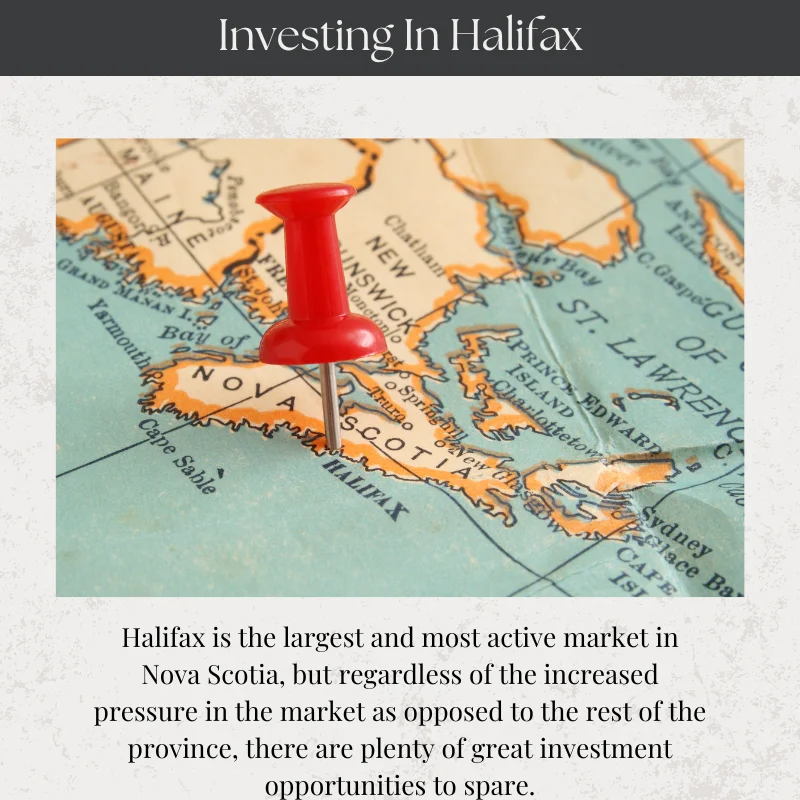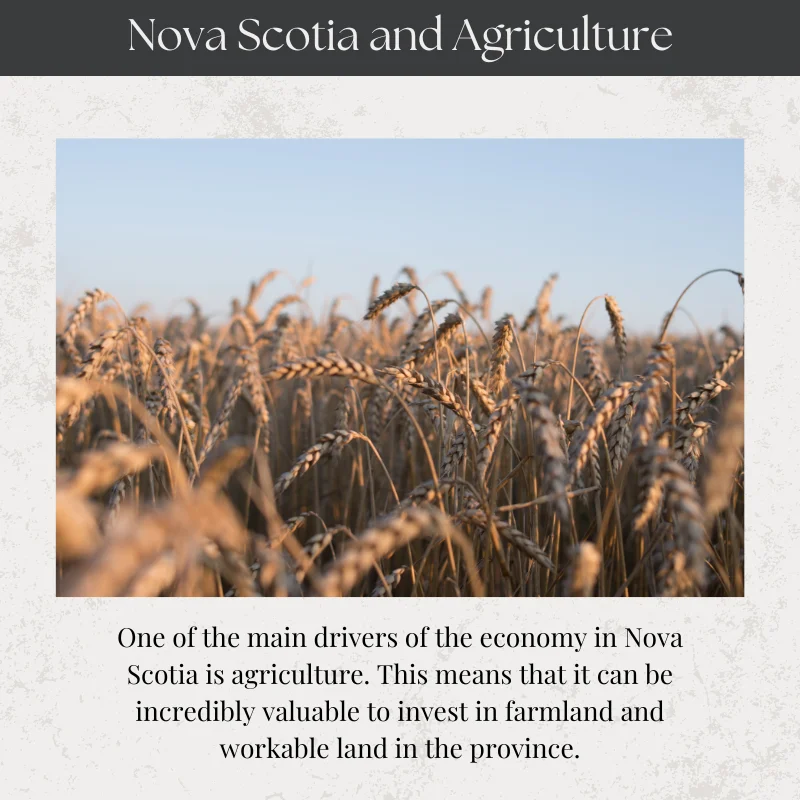Nova Scotia Real Estate Investing Success in 2023

Canadian real estate investment, like all investment ventures, requires a significant amount of homework and research before diving in. You want to feel confident that you have the information and qualifications that you need before you start sinking your hard-earned money into an investment, and real estate is no different. When looking into Canadian real estate, for example, you want to be certain that you have a handle on the differences between the provinces and territories.
Many investors might be tied to one particular province due to desire or family ties or other factors, but it’s still helpful to have a handle on any province’s particular challenges and opportunities. Things like demographics, income, tax rates and a host of other regulations can all help influence your decisions, so you want to be certain that you have a thorough understanding of these factors as you begin (or continue) your investing career. To help get you started, we are going to take you on a brief tour of Nova Scotia real estate so that you can better understand its characteristics, markets and opportunities that exist for real estate investors.
But first, if you are ready to dive into the Nova Scotia real estate market and need financing in order to get started, click the link below for a free strategy call with our team at LendCity today.
Nova Scotia Real Estate, New Investment Opportunities
Nova Scotia is the most populous of Canada’s three Maritime provinces and holds a fascinating position as a bridge between the old and the new. The province still relies heavily on traditional agriculture for much of its economic output and is the world’s largest exporter of berries, gypsum, lobster and even Christmas trees.
Nova Scotia has long been a key supplier of these items and more, and its resource-based economy means that it can be at the mercy of swings in the commodities markets that other provinces might not be.
On the other hand, the province has also benefited from heavy investment from the Canadian government. The defence and aerospace sector is a big benefactor of the region, and roughly half a billion dollars in revenues results from investment. Additionally, hundreds of information technology companies have laid down roots in the area and have become a reliable employer for thousands of Nova Scotians.
Additionally, Nova Scotia is and remains a popular tourist destination for many. Its beautiful sights and national parks draw around 1.6 million per year, and its cultural sites and museums fascinate visitors from around the world every single year. Many of the cities and towns that make up the Nova Scotia real estate market reap the rewards of this visitation, from large Halifax on down to many of the smaller communities.
Even tiny Inverness, with just 1200 full-time residents, has benefited from a boom in tourism that originated with the development and construction of two premium golf courses, so Nova Scotia real estate investment has a lot of interesting opportunities that can be powered by several different developments.
All of this indicates that investing in Nova Scotia real estate can cover several different opportunities. Real estate markets can vary across the province depending on the economic focus of a particular area, so it’s important to look into the different industries that have established themselves in a particular city or area of the land.
Discover How To Buy Unlimited Rental Properties With This Step By Step Guide
Key Demographics of Nova Scotia Real Estate
Nova Scotia is the seventh most populous province in Canada, which puts it right in the middle of the pack, but thanks to its small area it boasts the second-densest population density in the country. The province has been the benefactor most recently of interprovincial migration after losing out for years in this key marker for years—it has seen a significant uptick in recent years, which is surely a nod to the province’s changing economy.
Recent economic changes in Nova Scotia real estate have favoured more modernized industries like information technology, which can serve as a real draw for emigration, especially within a nation.
In keeping with its “New Scotland” name, the largest demographic in Nova Scotia (after those identifying simply as “Canadian”) is people of Scottish descent, who make up about 30% of the province’s entire population. Many Nova Scotians trace their heritage to other European nations, while many other residents trace their roots to Latin America, Asia and the First Nations of Canada.
The Nova Scotia Real Estate market, in particular, has benefited from an influx of immigrants to Canada in recent years. We’re proud to host these new Canadians, and their arrival in the Maritime provinces is a cause for celebration as they bring new skills and expertise to an area already rich with culture and diversity.
This increase in population coupled with the relatively flat supply of homes has led to a market that favours sellers—buyers have to act quickly if they’re interested in a property, and typically need to be prepared to bid over asking if they hope to have a shot at landing the home that they have their eye on.
Income Statistics of Nova Scotia
As was previously mentioned, Nova Scotia is transitioning into a more modern and technology-based economy but is still a largely a resource-based economy. As a result, the median family income (~$86,000) has traditionally been a bit below the national average (~$93,000), which could influence what types of properties you want to explore if looking into investing in Nova Scotia real estate. However, an important caveat to this is that in Halifax, the province’s largest metropolitan area, that number rises to over the national average (roughly $99,000) in Halifax, befitting its status as a cultural hotbed and the site of much of the economic transition that has been previously discussed.
As a result of these discrepancies, real estate investors in Nova Scotia want to be sure that they carefully examine income statistics that are directly related to the area which they’re exploring. Income statistics that cover an entire province are not entirely useful, as they do not tell the entire picture. Income can swing throughout a province, so localized information is going to prove to be the most useful. This is usually accessible via census data and can be a powerful tool when you’re exploring where to invest and what you’d like to invest in.
Nova Scotia Real Estate Prices
As with most of Canada, Nova Scotian real estate prices have been on a significant upswing since the pandemic has died down. The Canadian market has been hot as a whole, with home prices rising at a rate of about 12.5 percent from March 2019 to March 2020. Nova Scotia real estate has not quite hit these levels, but home prices have climbed at an appreciable rate of —9.6 percent over the same period. The average home price in Nova Scotia in March 2020 was around $288,000, a good jump over the previous March’s number of $263,000.
By the middle of 2022, prices have risen to an average of about $410,000. However, this does not mean that more affordable properties are not available if you know where to look and have a realtor who can help you navigate the Nova Scotia real estate scene.
The rental market in Nova Scotia real estate is a bit of a different proposition. Rentals are extremely popular in the province, as around 31 percent of Nova Scotians rent their living quarters. Only Nunavut (80 percent), Quebec (39 percent) and British Columbia (32 percent) can surpass this number of renters. To those of us interesting in investing in Nova Scotia real estate, this represents a real opportunity.
Buildings and properties that will be attractive to renters can find real pools of quality tenants in this province. Renting is extremely popular, so if you’re comfortable being a landlord and believe that you can find quality properties, then acquiring a property that can be rented out could be a good decision for you.
Canadian real estate has been hot for a while now until of course the specter of COVID-19 put a damper on things. The coronavirus has changed every single aspect of Canadian life, and the real estate market is of course no different.
However, that does not mean that the market has died down entirely. At the time of writing this article, the average one-bedroom in Halifax rents for over $1800. This means that investors can often expect high cash flow amounts from their property if they can keep their expenses in check.
Best Places to But Nova Scotia Real Estate
Halifax, Nova Scotia
The largest city in the province, Halifax is also its capital. It boasts a population of roughly 400,000 people across the entire municipality. The area’s labour force still participates heavily in extractive industries and agriculture, but Halifax is a cultural hotbed that’s also quite cosmopolitan.
The city is one of the biggest economic centers in the entire eastern part of the country and benefits from a concentration of both private employers and government agencies. The economy has seen fairly consistent growth over the last several years, which should help stem some of the interprovincial emigrations that have affected the Atlantic provinces over the past several decades. The city also deep roots in various primary industries, including agriculture, mining, fishing, forestry and fuel extraction (primarily natural gas). The province has a strong farming tradition in particular, with dozens of family farms still in existence as many others have been sold off across the country.
However, more modern industries are beginning to take hold as well, which can serve as a draw to new residents who will be hungry for the housing that real estate investors can help provide. Industries like healthcare and education are major employers, which means highly skilled workers are looking to move to the area.
When those workers arrive, they will find several wonderful cultural offerings. The Art Gallery of Nova Scotia is the largest of its kind in the Atlantic Provinces and houses many priceless works. There are also several festivals for residents to enjoy which reflect the vibrant population of the city. Places like The Khyber serve as multi-use facilities that host several different events.
The city is also beautiful, reflecting in many ways a culture that used to thrive all over the Atlantic Provinces before mass industrialization. Locations like Peggy’s Cove are beautiful rural communities and major tourist attractions, with both Canadian and international visitors drawn to its charm and nostalgia. Other sites like the Halifax Boardwalk take advantage of the splendid coastline and bring invaluable tourist dollars to the city.
If you want an example of how the market works through hard times, take a look at what the market did during the inventory shortage during the pandemic. As a result of the low inventory, prices were surging. Home costs had been jumping up all year, and some realtors projected them to continue increasing by as much as 10% by the end of 2020. The outlook for home prices meant that an investor could find the right deal there and felt confident that it will quickly appreciate.
Looking back, these predictions largely held true.

Sydney, Nova Scotia
The community of Sydney represents an interesting look into how Canadian towns and cities have evolved as a result of amalgamation. It was formerly a city until 1995 when it was folded into the regional municipality. It was formerly the capital of the Cape Breton Island colony until that colony merged with Nova Scotia in 1820, so you can feel confident that there’s still a strong independent streak in this community.
The city’s economy used to rely primarily on a massive steel mill that was one of the largest in North America. The decline of the steel and coal industries across the continent has resulted in some economic stagnation that has resulted in emigration, particularly by younger people, but there has been some great news in recent years. A massive harbour dredging project has turned the city into a world-class docking facility, and cruise ships teeming with tourists (and their dollars) has resulted in the city rebounding. Also responsible for this resurgence is Cape Breton University, which boasts over 5,500 students.
These students all need a place to live, so a real estate investor who is interested in short-term rentals will find some opportunities here. Additionally, the market here is intriguing because the region has such a low cost of living compared to many parts of Canada. This is a beautiful area that can draw in retirees, and its stability is one of its most enticing aspects.
Other towns to consider in Nova Scotia
Cape Breton Island is also an area that we recommend exploring. It’s one of the larger population centers in the Atlantic Provinces, and its recreational opportunities are one of its biggest selling points. It’s a popular destination for those who don’t mind commuting as long as it means living in a beautiful area, so the market here is heating up as inventory remains low.
Investing in Nova Scotia real estate means taking on properties in one of the most beautiful parts of the country. The province is still proud of its roots in industries like fishing and agriculture but has an eye towards the 21st century as more service-oriented fields begin to increase their foothold. All of this adds up to a place that should see sustained growth, with a real estate market to match.
Overall Nova Scotia Real Estate market overview
To sum up, the Nova Scotia real estate market provides a lot of opportunity for Canadian real estate investors. The Maritime provinces as a whole are heating up when it comes to real estate, buttressed primarily by population growth that can be attributed to both immigrants from outside Canada and interprovincial migration.
Halifax is, of course, the population center and the hottest real estate market when it comes to both rentals and purchases, so there could be some real opportunities there for investors with a bit of capital backing them up. There is even a local real estate investors meetup group so you can compare notes with other investors.
Beyond Halifax, Cape Breton represents another compelling opportunity if you’re exploring real estate investing in Nova Scotia real estate. Cape Breton is the second-largest population center in the province, and its market is comparably hot to Halifax’s as people with deep pockets arrive from abroad looking for a home in one of Canada’s most beautiful provinces.
Summary
Nova Scotia is one of the smaller provinces in Canada, but its density suggests a province that has community and urban culture, in addition to its mainstays of agricultural production and a reliance on the sea for a livelihood. The province has seen an economic retooling, with a focus on technology replacing or supplementing older extractive industries like mining or fishing.
All of these point to a region where skilled and higher-paid workers are likely to continue to move, creating a real estate market that can command higher sale and rental prices. If you’re looking for a province that is beginning to take a step towards a financially sustainable future, then investing in Nova Scotia real estate could be just the ticket for you.

Nova Scotia Real Estate Professionals
We have searched high and low for real estate investing professionals in Nova Scotia. Below, you can find professionals we have researched and can confirm they specialize in working with Real Estate Investors.
To ensure the maximum success in real estate investing in Nova Scotia, or any city, you should always use professionals who understand and work with investors, your income depends on it.
This list may not fully list all the professionals in the area, but the ones we have personally investigated and that we would refer our clients to.
If you’re a real estate professional and would like us to consider adding you to the list, please contact us.
Mortgage Broker
LendCity Mortgages – Website – Click to Email – Click to Call
Alternatively, you can click the link below for a free strategy call to discuss investing in Nova Scotia real estate with the best available financing.
